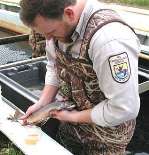
Clarkson to Receive $6.5M to Continue Monitoring Great Lakes' Fish
With SUNY, the universities will monitor temporal trends in bioaccumulative chemicals in the Great Lakes using top predator fish as biomonitors.
The U.S. Environmental Protection Agency has awarded Clarkson University a $6.5 million, five-year grant to continue its partnership with The State University of New York (SUNY) Fredonia and SUNY Oswego to conduct the Great Lakes Fish Monitoring and Surveillance Program.
EPA awarded this same partnership team $1.75 million in 2006 to provide chemical analysis of Great Lakes fish tissue. The funding is part of the Great Lakes Restoration Initiative.
Principal investigators Thomas M. Holsen, professor of Civil & Environmental Engineering at Clarkson; Philip K. Hopke, director of the Institute for a Sustainable Environment at Clarkson, and Bernard S. Crimmins, who is working in the Center for Air Resources Engineering and Science at Clarkson, are responsible for overall program management. James Pagano, director, Environmental Research Center (ERC), Department of Chemistry at SUNY Oswego, and Michael Milligan, professor, Department of Chemistry at SUNY Fredonia are also principal investigators in this study.
The new funding will continue analysis for contaminants to assess temporal trends in organic compounds and mercury in open waters of the Great Lakes, using fish as biomonitors. During the next five years, researchers will obtain additional analytical instruments to help identify both current and emerging contaminants, such as flame retardants, present in the Great Lakes ecosystem.
“The magnitude of this project recognizes Clarkson University’s commitment to the quality of the natural environment in our region and the positive collaboration of the research team to maximize the scholarly expertise found in New York state laboratories at Clarkson, SUNY Oswego and SUNY Fredonia,” said Clarkson President Tony Collins.
Together, this group will monitor temporal trends in bioaccumulative chemicals in the Great Lakes using top predator fish as biomonitors, screen for new compounds of concern entering the Lake ecosystems, and assess the ecological health of the Great Lakes through interpretation of chemical analyses and other food web studies. This study will improve the understanding of pollutant impacts on the fishery and efforts to remediate and reduce pollutant sources.
Source: Clarkson University